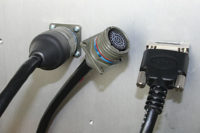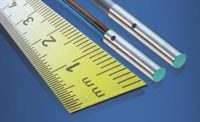There have been many exciting developments over the past several years with the introduction of new vision technologies and standards. We have seen the launch of new benchmarks—such as Camera Link HS, CoaXPress, and most recently USB 3.0 Vision—join the ranks of well-established standards such as Camera Link and Gig E Vision. Each one of these standards has its own unique specifications and capabilities such as data transfer rates, camera control, or trigger latency. However, all of these technologies share one common need: none of these systems will function without the use of a cable. The cable is critical in providing the pathway for data from computer-to-camera and camera-to-computer.
It is the essential lifeline between the device and its host. Unfortunately, that link may come up short—literally—for your specific application and may be overlooked until the time of implementation. We have received a few calls over the years from frantic system integrators and end users as they have recognized that they are exceeding the effective length of cables in their application. Each application and standard has a particular maximum effective cable length. In this article, we will explore this phenomenon and provide guidance on how to select appropriate cables for your project.
Passive copper cables:
Each vision technology relies on the use of copper cables. As a signal is passed from one end of a cable to the other cable end, there is a natural loss and degradation in signal strength. In our industry, we call this attenuation. For those technologies that send signals down multiple pairs of conductors, such as Camera Link, not only is attenuation a concern, but an occurrence termed signal skew also becomes a factor. Signal skew is a measurement in which closely matched signals—which are sent at the same time through multiple conductors—arrive slightly apart at the other end of the cable. If there is too much signal skew, data transmitted over the cable can no longer be properly interpreted.
Each of the technologies has a different tolerance level for the amount of attenuation or skew they can accept. Additionally, technologies that provide high bandwidth and high data transfer rates may also be more sensitive to degradation of attenuation or skew. Technologies that rely on parallel signal processing over multiple lines are greatly impacted by skew while technologies such as CoaXPress are immune as all their data is transmitted over just one conductor.
The typical effective length (passive cables) for each of the major technologies is shown in table 1.
Active copper cables:
The effective lengths of copper cables can be increased by incorporating signal conditioning and/or repeating devices and modules into the cable to de-skew parallel signals or boost the signal so that it can be transferred over a longer distance. Depending on the signal conditioning being used, cable lengths can be more than doubled. In the case of repeaters, cables can have their effective length extended multiple times. However, when incorporating cables with signal conditioning capabilities, one trade-off that must be considered is that circuitry is added into the back shell of the connector. This results in a much larger connector back shell or overmold, which then takes additional space at both the camera and computer end of the cable.
With repeaters, modules are incorporated at various intervals along the length of the cable which can be very problematic for cables that must pass through tight spaces. Further consideration should also be given for those applications that require repeated flexing of the cable, such as in Catrac systems (rolling flex) or torsional flex applications. Utilizing repeaters in these types of applications may not be an option as they are not designed for the physical stresses associated with these high flex applications, whereas they could be a very effective solution otherwise for static applications.
Fiber Optic cables:
Fiber optic cables do not utilize electrical signals to transmit information through the cable. Instead, optical light waves are used to transfer data from the camera to computer. Great advances have been made in miniaturizing the electronics needed to convert electrical signals to optical signals in the connectors located at both ends of the cable. These are often self-contained in modules no larger than the standard back shells and overmolds that are used on conventional copper cable assemblies. Use of fiber optic cabling allows for distances of several kilometers between camera and computer. One potential problem to keep in mind is that a power source is still needed to supply the camera, which will require the use of a copper cable; power cables are still vulnerable to voltage drop over distance, so maintaining enough consistent power to operate your camera may require extra consideration.
Fiber optic cables have been in use for more than 10 years in Camera Link applications and are now available for the newest technologies such as USB 3.0 Vision. Fiber optic assemblies are readily available in common length increments. Although they offer longer distances than their copper counterparts, fiber optic cables are currently not available in various configurations such as custom lengths or with right angle overmolds/connectors. Some high flex fiber optic cables are available but careful investigation must be done to understand the parameters under which the fiber optic cable was tested and qualified. Progressive cable suppliers will be able to provide you with detailed test data and may also offer customized testing of their cable in simulated applications so that cable life and signal integrity performance can be accurately predicted. These simulated tests may require a nominal fee but that small investment can provide significant payback by greatly reducing or eliminating the risk of unplanned equipment down time due to a cable failure.
It is my hope that the information contained here will help you to make a well informed decision as you determine what technology should be used for your application. Utilize the checklist below to reduce the risk of coming up cable short in your next machine vision application.
What is the maximum effective length of passive cables for the technology you wish to employ?
If passive copper cables are not able to achieve the required distance which of the solutions noted above are readily available?
Are there considerations that should be made for the space needed to implement either active or fiber optic cable solutions?
If the application requires a high flex solution are cables readily available, appropriately designed, and validated for the type of flex/motion that the cable will be subjected to?
Tip: Although not always feasible, reducing the speed of data transfer can often result in lengthening the effective lengths of passive cables.





